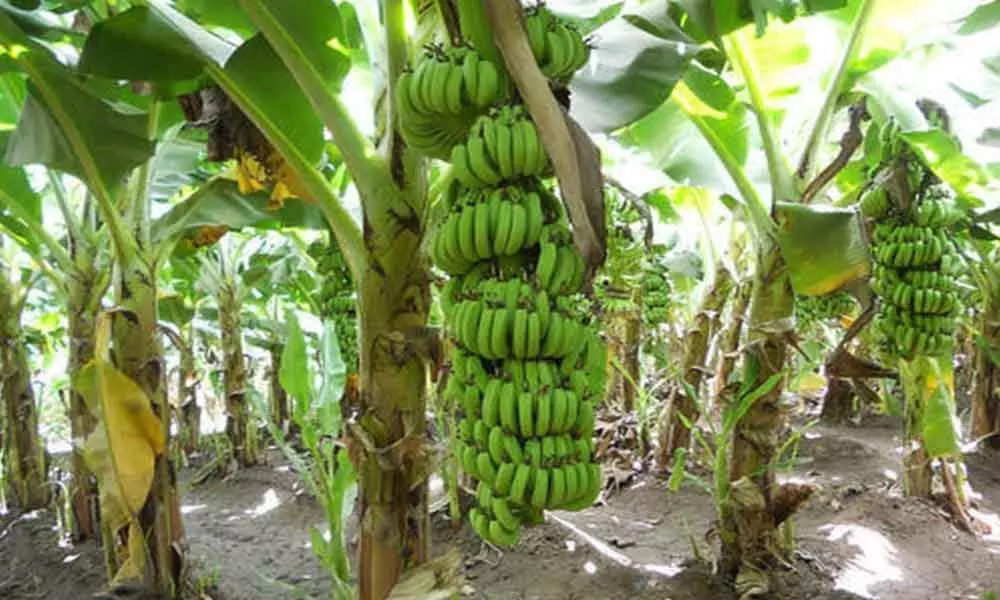Live
- 39 transgenders recruited as Traffic Assistants
- Jesus’ teachings promote unity, compassion: Haryana Governor
- Special drive held on road safety
- Simultaneous elections not imminent: Purandeswari
- Vaktha helping transform individuals as leaders
- Pariksha Pe Charcha 2025
- Cops crack sensational NH-44 robbery
- Train services disrupted over technical glitch at platform 3
- KCR has public support, claim Ponnala, Vinay Bhaskar
- Attada’s novel on Srikakulam struggle lauded
Just In
Banana plants used to develop eco-friendly packaging material: Study


Scientists, including one of Indian origin, on Friday claimed to have developed a novel method to turn banana plantation waste into biodegradable and recyclable packaging material.
Scientists, including one of Indian origin, on Friday claimed to have developed a novel method to turn banana plantation waste into biodegradable and recyclable packaging material.
According to the researchers from the University of New South Wales (UNSW) in Australia, the banana growing industry produces large amounts of organic waste, with only 12 percent of the plant being used while the rest is discarded after harvest.
"What makes the banana-growing business particularly wasteful compared to other fruit crops is the fact that the plant dies after each harvest," said UNSW Associate Professor Jayashree Arcot. "We were particularly interested in the pseudostems - basically the layered, fleshy trunk of the plant which is cut down after each harvest and mostly discarded on the field. Some of it is used for textiles, some as compost, but other than that, it is a huge waste," Arcot said in a statement. Arcot and Martina Stenzel, a professor at UNSW, wondered whether the pseudostems would be valuable sources of cellulose -- an important structural component of plant cell walls.
This cellulose could then be used in packaging, paper products, textiles and even medical applications such as wound healing and drug delivery, the researchers said. Using a reliable supply of pseudostem material from banana plants grown at the Royal Botanic Garden Sydney, the researchers extracted cellulose to test its suitability as a packaging alternative. "The pseudostem is 90 percent water, so the solid material ends up reducing down to about 10 percent," Arcot said. "We bring the pseudostem into the lab and chop it into pieces, dry it at very low temperatures in a drying oven, and then mill it into a very fine powder," she said. The researchers then take this powder and wash it with a very soft chemical treatment.
This isolates nano-cellulose which is a material of high value with a whole range of applications, they said. "One of those applications that interested us greatly was packaging, particularly single-use food packaging where so much ends up in landfill," said Stenzel. When processed, the material has a consistency similar to baking paper. Arcot said depending on the intended thickness, the material could be used in a number of different formats in food packaging. "There are some options at this point, we could make a shopping bag, for example," she said. "Or depending on how we pour the material and how thick we make it, we could make the trays that you see for meat and fruit. "Except of course, instead of being foam, it is a material that is completely non-toxic, biodegradable and recyclable," said Arcot.
The researchers confirmed in tests that the material breaks down organically after putting 'films' of the cellulose material in soil for six months. The results showed that the sheets of cellulose were well on the way to disintegrating in the soil samples. "The material is also recyclable. One of our PhD students proved that we can recycle this for three times without any change in properties," Arcot said. The researchers said that tests with food have proved that it poses no contamination risks. "We tested the material with food samples to see whether there was any leaching into the cells," Stenzel said. "We didn't see any of that. I also tested it on mammalian cells, cancer cells, T-cells and it is all non-toxic to them. So if the T-cells are happy -- because they are usually sensitive to anything that is toxic -- then it's very benign," she said.

© 2024 Hyderabad Media House Limited/The Hans India. All rights reserved. Powered by hocalwire.com






